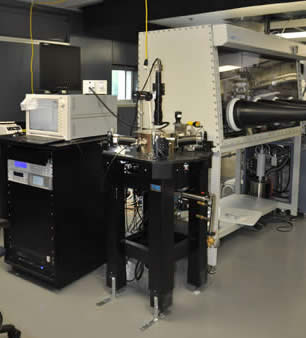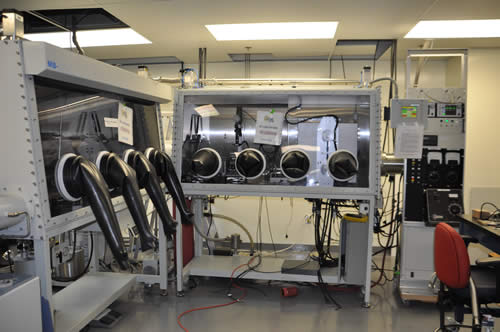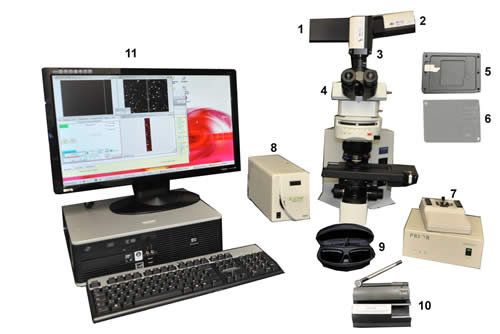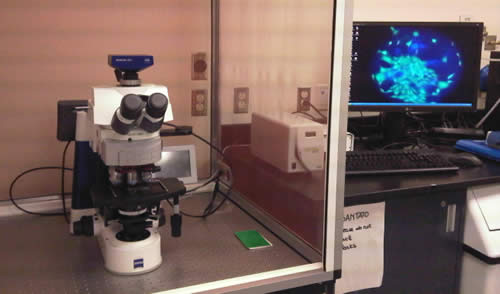Our laboratory is in Pavillon J.-A. Bombardier LABORATORY (#3312 and #3320)
 The probe station (CPX Lakeshore) is directly connected through a transfer arm to a N2 Glove box (Glove box 1). The environment in the probe station can be varied depending on the requirements of the characterization ( vacuum P=10-6 Torr, N2, etc). The station is also equipped with a heating stage. One probe includes a Si photodiode for the characterization of light-emitting devices (light-emitting transistors, light-emitting electrochemical cells).
The probe station (CPX Lakeshore) is directly connected through a transfer arm to a N2 Glove box (Glove box 1). The environment in the probe station can be varied depending on the requirements of the characterization ( vacuum P=10-6 Torr, N2, etc). The station is also equipped with a heating stage. One probe includes a Si photodiode for the characterization of light-emitting devices (light-emitting transistors, light-emitting electrochemical cells).
Glove box 1 hosts spin coating systems and hot plates for solution processing of thin films.
 In collaboration with the research groups of Profs R. Martel and S. Kena-Cohen
In collaboration with the research groups of Profs R. Martel and S. Kena-Cohen
Glove box 2 hosts a probe station to be used for electrical characterizations at room temperature in N2 atmosphere. This probe station is equipped with an optical imaging system for electroluminscence imaging. Glove box 3 includes a vacuum evaporation system for organic molecular materials and metals.
The system is composed of an Olympus BX51 inverted microscope and a Fluorescence Hyper-spectral Imaging system PARISS (Prism and Reflector Imaging Spectroscopy System, LightFormInc., USA). PARISS in itself consists of an imaging spectrometer coupled to a cooled scientific CCD camera to record spectra.
The hyper-spectral images (spectral maps) are generated in "push broom" mode by use of a wavelength-dispersive spectrometer collecting all wavelengths simultaneously at each location along the slit by translating the field of view (FOV) underneath the spectrometer on an automated translation stage connected to the Olympus BX-51. The data (tif, prs file format) are collected with PARISS 8 software with an associated minimum correlation coefficient (minCC) 98, in real time. The image size and spatial resolution is calculated by dividing the slit height (5 mm) and slit width (25µm) to the magnification of the objective lens of the microscope. Fluorescence images and spectra can be obtained for excitation wavelengths of λmax= 360, 460, 540 nm. Gray scale images can be collected in the bright field (BF) mode.
PARISS 8 software has a further use: analyzing the collected information and categorizing the spectral libraries into classes. Later, classes of spectra can be given pseudo color codes which are correlated and painted onto the FOV in its associated pseudo color, forming the classified images.

- PARISS (Prism and Reflector Imaging Spectroscopy System, LightFormInc.
- Imaging system which belongs to the PARISS (for simultaneous imaging of sample with the spectra)
- Optical imaging camera to focus the sample
- OLYMPUS BX-51 inverted microscope
- Standard sample holder for slides (max length-width 7.5cm-7.5cm)
- Quartz sample holder (can be used for all dimensions of samples)
- Automatic stage controller (joystick)
- X-cite series 120Q (EXFO) light source (Mercury lamp)
- NIR range protective glasses
- MDIL calibration lamp for PARISS calibration
- PARISS8 software to collect and analyze the data (see LightForm Inc website for more information)
FILTERS: Bright field (UMBF-3); Dark field (phase 45°); GFP (peak max=460 nm) (Long pass filter); Rhodamine (peak max=540 nm) (Long pass filter)
 Equipment of the Department of Engineering Physics
Equipment of the Department of Engineering Physics
The system is composed of a Carl Zeiss upright microscope with polarization unit which permits polarized light imaging as well as fluorescence and transmission mode imaging. 10, 20, 40, 63, 100X objective lenses are available for use. The microscope is operated with a software called AxioVision Rel 4.8 from the computer. Image acquisition modules enable the user to obtain a high depth of field (Z-stack) and the use of different filters to differentiate regions with particular optical properties (multichannel fluorescence). Image analysis tools like particle analyzer, grains, topography, scaling, spectral properties are available. For a better understanding of the microscope, please refer to the following link: AxioVision.
In collaboration with the research groups of Profs F. Cicoira and M. Meunier
VSP 300 multichannel potentiostat from Biologic (equipped with impedance modulus); Versa STAT 4 potentiostat from Princeton Applied Research (equipped with impedance modulus).
Software controlled B2902A source measure unit from Agilent is coupled to a glove box where we can control the relative humidity (RH) from ambient conditions up to 90% RH.


